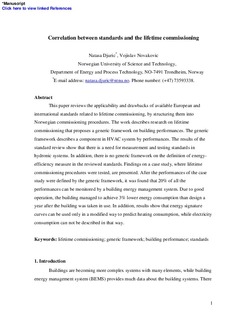| dc.contributor.author | Djuric, Natasa | |
| dc.contributor.author | Novakovic, Vojislav | |
| dc.date.accessioned | 2019-02-25T12:13:50Z | |
| dc.date.available | 2019-02-25T12:13:50Z | |
| dc.date.created | 2009-12-14T13:49:41Z | |
| dc.date.issued | 2010 | |
| dc.identifier.citation | Energy and Buildings. 2010, 42 (4), 510-521. | nb_NO |
| dc.identifier.issn | 0378-7788 | |
| dc.identifier.uri | http://hdl.handle.net/11250/2587236 | |
| dc.description.abstract | This paper reviews the applicability and drawbacks of available European and international standards related to lifetime commissioning, by structuring them into Norwegian commissioning procedures. The work describes research on lifetime commissioning that proposes a generic framework on building performances. The generic framework describes a component in HVAC system by performances. The results of the standard review show that there is a need for measurement and testing standards in hydronic systems. In addition, there is no generic framework on the definition of energy-efficiency measure in the reviewed standards. Findings on a case study, where lifetime commissioning procedures were tested, are presented. After the performances of the case study were defined by the generic framework, it was found that 20% of all the performances can be monitored by a building energy management system. Due to good operation, the building managed to achieve 3% lower energy consumption than design a year after the building was taken in use. In addition, results show that energy signature curves can be used only in a modified way to predict heating consumption, while electricity consumption cannot be described in that way. | nb_NO |
| dc.language.iso | eng | nb_NO |
| dc.publisher | Elsevier | nb_NO |
| dc.rights | Attribution-NonCommercial-NoDerivatives 4.0 Internasjonal | * |
| dc.rights.uri | http://creativecommons.org/licenses/by-nc-nd/4.0/deed.no | * |
| dc.title | Correlation between standards and the lifetime commissioning | nb_NO |
| dc.type | Journal article | nb_NO |
| dc.type | Peer reviewed | nb_NO |
| dc.description.version | acceptedVersion | nb_NO |
| dc.source.pagenumber | 510-521 | nb_NO |
| dc.source.volume | 42 | nb_NO |
| dc.source.journal | Energy and Buildings | nb_NO |
| dc.source.issue | 4 | nb_NO |
| dc.identifier.doi | 10.1016/j.enbuild.2009.10.020 | |
| dc.identifier.cristin | 346450 | |
| dc.description.localcode | © 2009. This is the authors’ accepted and refereed manuscript to the article. This manuscript version is made available under the CC-BY-NC-ND 4.0 license http://creativecommons.org/licenses/by-nc-nd/4.0/ | nb_NO |
| cristin.unitcode | 194,64,25,0 | |
| cristin.unitname | Institutt for energi- og prosessteknikk | |
| cristin.ispublished | true | |
| cristin.fulltext | postprint | |
| cristin.qualitycode | 2 | |

